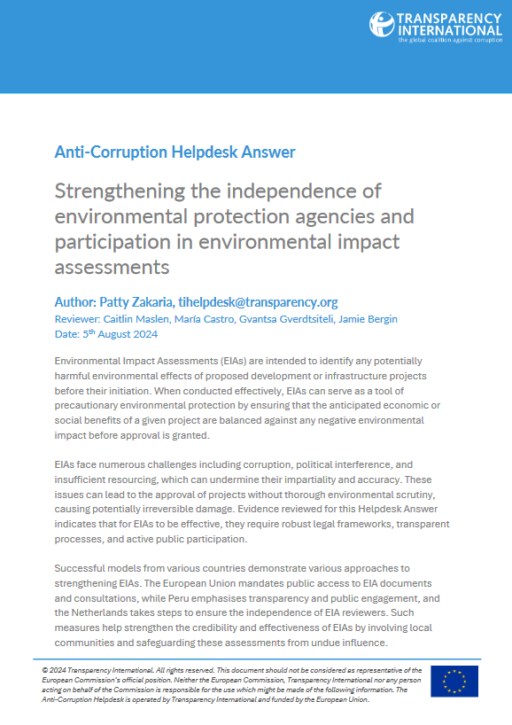- Home
- Anti-Corruption Helpdesk
- Strengthening the independence of environmental protection agencies and participation in environmental impact assessments
Strengthening the independence of environmental protection agencies and participation in environmental impact assessments

This Anti-Corruption Helpdesk brief was produced in response to a query from one of Transparency International’s national chapters. The Anti-Corruption Helpdesk is operated by Transparency International and funded by the European Union.
Query
Please provide case studies or examples of best practices from other countries where political influence in environmental governance has been effectively mitigated, particularly regarding legal frameworks or policies ensuring the independence of environmental agencies? What are some successful models or tools used in other countries to enhance public participation in the environmental impact assessment (EIA) process? Are there any success stories from other countries where environmental governance and EIA processes have been significantly improved?
Summary
Environmental Impact Assessments (EIAs) are intended to identify any potentially harmful environmental effects of proposed development or infrastructure projects before their initiation. When conducted effectively, EIAs can serve as a tool of precautionary environmental protection by ensuring that the anticipated economic or social benefits of a given project are balanced against any negative environmental impact before approval is granted.
EIAs face numerous challenges including corruption, political interference, and insufficient resourcing, which can undermine their impartiality and accuracy. These issues can lead to the approval of projects without thorough environmental scrutiny, causing potentially irreversible damage. Evidence reviewed for this Helpdesk Answer indicates that for EIAs to be effective, they require robust legal frameworks, transparent processes, and active public participation.
Successful models from various countries demonstrate various approaches to strengthening EIAs. The European Union mandates public access to EIA documents and consultations, while Peru emphasises transparency and public engagement, and the Netherlands takes steps to ensure the independence of EIA reviewers. Such measures help strengthen the credibility and effectiveness of EIAs by involving local communities and safeguarding these assessments from undue influence.
Main points
- EIAs are common instruments to identify and mitigate the environmental impacts of proposed projects and supporting sustainable development.
- Corruption in the EIA process often manifests through practices such as bribery, where project proponents may offer financial incentives to those conducting the assessment in exchange for favourable assessment outcomes or the omission of necessary environmental checks.
- Infrastructure projects in particular can be lucrative opportunities for clientelist practices, and unscrupulous officials may be unwilling to allow environmental concerns prevent them from awarding contracts to their cronies.
- Similarly, political influence presents a significant risk, as governmental officials may exert pressure during the EIA process to secure political expedient outcomes, which may involve prioritising short-term economic gains over environmental sustainability (Nkoh 2023). Such influence is particularly problematic in jurisdictions where political agendas heavily favour rapid economic growth, which can lead to EIAs becoming mere formalities with predetermined outcomes that consistently favour economic outcomes, regardless of potential adverse environmental impacts (Caro-Gonzalez et al. 2023).
- Robust legal frameworks, public participation and transparent assessment processes are needed for EIAs to be impartial, credible, and objective.
- The European Union mandates public access to EIA documents and consultations; Peru focuses on transparency and public engagement; the Netherlands ensures independent EIA reviewers.
- Early and sustained involvement of local communities should not be viewed as a formality but rather a crucial element that enhances the credibility and effectiveness of EIAs.
Contents
- Introduction
- Environmental protection agencies and their EIA mandate
- Challenges to the EIA mandate of Environmental Protection Agencies
- Measures to strengthen environmental protection agencies
- Measures to strengthen public participation in environmental impact assessments
- References
Caveat
There are any many potential measures to improve the governance of environmental protection agencies (EPAs) and the process of conducting environmental impact assessments (EIAs). This Helpdesk Answer focuses on two in particular: strengthening the independence of EPAs and enhancing public participation in EIAs.
Authors
Patty Zakaria, [email protected]
Reviewers
Caitlin Maslen, María Castro, Gvantsa Gverdtsiteli
Date
05/09/2024
Tags
 Download PDF
Download PDF
